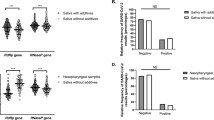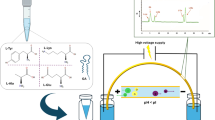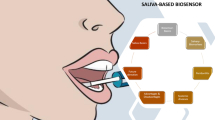Abstract
Saliva has garnered a lot of interest as a non-invasive, easy to collect, and biochemical rich sample for attenuated total reflection-Fourier transform infrared spectroscopy (ATR-FTIR) based disease diagnosis. Although a large number of studies have explored its potential, the preparation methods used differ greatly. For large scale clinical studies to aid translation into clinics, the collection/processing methodology needs to be standardized. Therefore, in this study, we explored different saliva collection (spitting, method A/cotton soaking, method B) and processing protocols (unprepared, TS; supernatant from the centrifugation, CS; and drying, C) to find which gives the best ATR-FTIR signals. Analysis showed highest proteins, carbohydrates, amino acids, and nucleic acid + proteins/lipids in BTS, BCS, ACS, and BC, respectively. Notably, only BC shows a 1377 cm−1 nucleic acid band that is also uniquely identified in multivariate analysis. We conclude that the collection-processing protocol should be based on a biochemical component that best gives a differential diagnosis.
Similar content being viewed by others
References
Y.-H. Lee and D. T. Wong, Am. J. Dent., 2009, 22, 241.
S. Khaustova, M. Shkurnikov, E. Tonevitsky, V. Artyushenko, and A. Tonevitsky, Analyst, 2010, 135, 3183.
C. Júnior, P. Cesar, J. F. Strixino, and L. Raniero, Res. Biomed. Eng., 2015, 31, 116.
P. D. Slowey, in “Advances in Salivary Diagnostics”, 2015, Springer, 33–61.
L. M. Rodrigues, T. D. Magrini, C. F. Lima, J. Scholz, H. da Silva Martinho, and J. D. Almeida, Spectrochim. Acta, Part A, 2017, 174, 124.
L. Leal, M. Nogueira, R. Canevari, and L. Carvalho, Photodiagn. Photodyn. Ther, 2018, 24, 237.
N. Simsek Ozek, I. Zeller, D. Renaud, P. Gümüş. N. Nizam, F. Severcan, N. Buduneli, and D. Scott, J. Dent. Res., 2016, 95, 1472.
I. Badea, M. Crisan, F. Fetea, and C. Socaciu, Romanian Biotechnol. Lett., 2014, 19, 9817.
S. Martí-Álamo, A. Mancheño-Franch, C. Marzal-Gamarra, and L. Carlos-Fabuel, J. Clin. Exp. Dent., 2012, 4, e237.
S. Mittal, V. Bansal, S. K. Garg, G. Atreja, and S. Bansal, J. Clin. Exp. Dent., 2011, 3, e314.
E. Kaufman and I. B. Lamster, Crii. Rev. Oral Biol. Med., 2002, 13, 197.
J. Ferlay, I. Soerjomataram, R. Dikshit, S. Eser, C. Mathers, M. Rebelo, D. M. Parkin, D. Forman, and F. Bray, Int. J. Cancer, 2015, 136, E359.
C. Rivera, Int. J. Clin. Exp. Pathol., 2015, 8, 11884.
R. Sankaranarayanan, K. Ramadas, H. Amarasinghe, S. Subramanian, and N. Johnson, “Disease Control Priorities”, 3rd ed 2015, World Bank Group, 85.
A. Jafari, S. Najafi, F. Moradi, M. Kharazifard, and M. Khami, J. Dent., 2013, 14, 146.
D. V. Messadi, Int. J. Oral Sci., 2013, 5, 59.
R. Mehrotra and D. K. Gupta, Head & Neck Oncology, 2011, 3, 33.
Y. Baskin and T. Yigitbasi, Curr. Genomics, 2010, 11, 528.
M. T. Weigel and M. Dowsett, Endocrine—Related Cancer, 2010, 17, R245.
L. Bel’skaya, E. Sarf, and N. Makarova, J. Appl. Spectrosc., 2018, 85, 445.
P. Seredin, D. Goloshchapov, Y. Ippolitov, and J. Vongsvivut, Biomed. Opt. Exp., 2019, 10, 4050.
S. Jaychandran, P. Meenapriya, and S. Ganesan, Int. J. Oral. Craniofac. Sci., 2016, 2, 11.
J. M. Connolly, K. Davies, A. Kazakeviciute, A. M. Wheatley, P. Dockery, I. Keogh, and M. Olivo, Nanomed.— NanotechnoL, Biol. Med., 2016, 12, 1593.
S. Fujii, S. Sato, K. Fukuda, T. Okinaga, W. Ariyoshi, M. Usui, K. Nakashima, T. Nishihara, and S. Takenaka, Anal. Sci., 2016, 32, 225.
T. Barranco, J. J. Cerón, P. Lopez-Jornet, J. Pastor, J. M. Carrillo, M. Rubio, P. L. Tornei, R. Cugat, F. Tecles, and A. Tvarijonaviciute, Anal. Sci., 2018, 34, 619.
P. Rekha, P. Aruna, E. Brindha, D. Koteeswaran, M. Baludavid, and S. Ganesan, J. Raman Spectrosc., 2016, 47, 763.
T. Bhattacharjee, A. Khan, G. Maru, A. Ingle, and C. M. Krishna, Analyst, 2015, 140, 456.
A. Zlotogorski-Hurvitz, B. Z. Dekel, D. Malonek, R. Yahalom, and M. Vered, J. Cancer Res. Clin. Oncol., 2019, 145, 685.
Acknowledgments
The authors would like to thank the Coordenaçào de Aperfeiçoamento de Pessoal de Nível Superior (CAPES) for the Breno Pupin scholarship (CAPES PNPD 20132078-330510110009P0), Daniele Riêra Paschotto (CAPES, PROSUC, Financing Code 001) and Tanmoy T. Bhattacharjee (PNPD/CAPES/ 2016) scholarship.
Author information
Authors and Affiliations
Corresponding author
Rights and permissions
About this article
Cite this article
Paschotto, D.R., Pupin, B., Bhattacharjee, T.T. et al. Saliva Preparation Method Exploration for ATR-FTIR Spectroscopy: Towards Bio-fluid Based Disease Diagnosis. ANAL. SCI. 36, 1059–1064 (2020). https://doi.org/10.2116/analsci.20P029
Received:
Accepted:
Published:
Issue Date:
DOI: https://doi.org/10.2116/analsci.20P029




